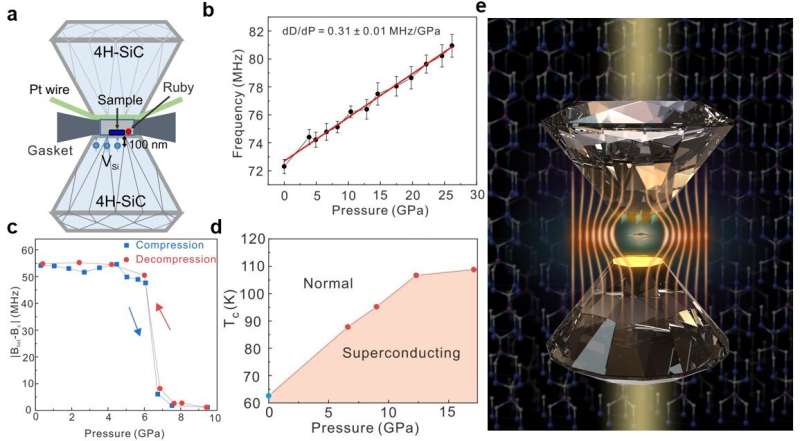a. Schematic diagram of moissanite anvil cell and detection of magnetic samples by shallow silicon vacancy defects; b. Relationship of zero-field splitting of silicon vacancy defects with pressure; c. Magnetic phase transition detection of Nd2Fe14b materials; d. Tc-P phase diagram of YBCO superconducting material; e. Illustration of high-pressure in-situ magnetic detection based on silicon vacancy defects in silicon carbide. Credit: HFIPS
According to a study published in Nature Materials, a collaborative research team from the Hefei Institutes of Physical Science of the Chinese Academy of Sciences (CAS) and the University of Science and Technology of China has developed a research platform to study superconducting magnetic detection and magnetic phase transitions of hydrides under high pressure.
High-resolution in-situ magnetic measurement under high pressure has been a challenge. It has limited the progress of research on the Meissner effect of superconductivity and on magnetic phase transition behavior under high pressure. Using the optically detected magnetic resonance (ODMR) technique on diamond nitrogen vacancy (NV) centers has helped in-situ detection of pressure-induced magnetic phase transitions. However, it is not convenient to analyze and interpret the measured ODMR spectra because the NV center has four axial directions and zero-field splitting is temperature dependent.
In this study, the researchers have for the first time realized high-pressure in-situ quantum magnetic detection based on the silicon vacancy (VSi) defects in silicon carbide and solved the problem of high-pressure magnetic detection.
The researchers used ion implantation to generate shallow VSi defects on the surface of a processed silicon carbide anvil cell. VSi defects in silicon carbide have only one axial direction. Due to the special symmetry of silicon carbide's electronic structure, zero-field splitting is insensitive to temperature, thus the problem of temperature variations in high-pressure sensing can be avoided.
The researchers found that the spectrum of VSi defects shifted blue and the zero-field splitting value varied little with pressure (0.31 MHz/GPa)—much less than the slope of diamond NV centers (14.6 MHz/GPa). This is helpful for the measurement and analysis of ODMR spectra under high pressure.
By using ODMR technology on VSi defects, the researchers observed the pressure-induced magnetic phase transition of Nd2Fe14B magnets at about seven GPa, and measured the critical temperature-pressure phase diagram of the YBa2Cu3O6.6 superconductor.
This technique is of great significance to the field of high-pressure superconductivity and magnetic materials, according to the researchers.
By demonstrating the use of room-temperature spin-defects in silicon carbide as in-situ high pressure sensors, this work opens the door to new studies of quantum materials using Moissanite anvil cells.
More information: Xiao-Di Liu, Magnetic detection under high pressures using designed silicon vacancy centres in silicon carbide, Nature Materials (2023). DOI: 10.1038/s41563-023-01477-5. www.nature.com/articles/s41563-023-01477-5
Journal information: Nature Materials
Provided by Chinese Academy of Sciences























